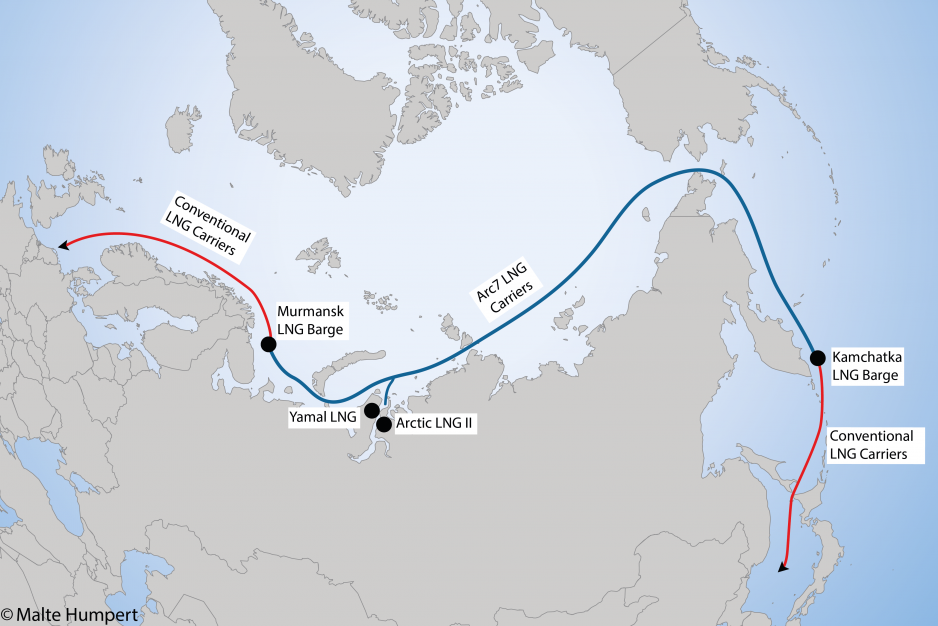Novatek Transships LNG near Murmansk While Super Icebreaker Arktika Completes First Escort

Rosatomflot’s newest nuclear icebreaker Arktika during its first escort. (Courtesy: Rosatomflot)
Russian natural gas company Novatek tested the reloading of LNG in the Kildin Strait of the Barents Sea optimizing its export of LNG to Europe. Meanwhile Rosatomflot’s newest nuclear icebreaker Arktika successfully completed its first escort through the icy waters of Ob Bay.
Novatek’s complex transport network to deliver liquefied natural gas (LNG) from the Yamal Peninsula to Europe is taking further shape. This week the company put in place the latest piece of its Arctic logistics puzzle: the reloading of LNG from ice-breaking vessels to conventional gas carriers off the waters of Murmansk.
These types of transfers will ensure uninterrupted year-round export of Yamal LNG to Europe resulting in a growing number of LNG carriers passing through Norway’s shipping lanes.
“The ship-to-ship transshipment complex in the Murmansk Region represents another significant milestone in developing Novatek’s LNG supply chain from the LNG facilities located in the Russian Arctic to the global natural gas consuming markets,” the company explained in a statement.
Earlier this summer the company conducted a trial of the Kildin anchorage and confirmed that it would be suitable for reloading LNG. During these operations gas is transferred from Arc7 ice-breaking LNG carriers to conventional carriers, allowing Novatek to limit the distance its fleet of ice-breaking tankers have to travel.
Leaving Norway behind
Between 2018-2020 Novatek, in cooperation with the Norwegian company Tschudi, utilized Sarnes Fjord near Honningsvåg to transfer more than 10m tons of LNG. At the time the U.S. voiced its displeasure at this cooperation with Russia in the hydrocarbon sector.
The U.S. opposition at least in part prompted Novatek to relocate transfer operations to the Russian side of the Barents Sea, even though the area near Honningsvåg sees calmer waters and is thus more favorable for operations.
The first transshipment occurred between the Arc7 LNG tanker Nikolay Yevgenov and the conventional tanker Yamal Spirit. For now the transfers are ship-to-ship where both vessels are connected via hoses.
Transfers can take up to 48 hours. Starting in 2022 the company will make use of a floating LNG storage barge which can hold two ships’ worth of LNG.
The barge will receive LNG from the Arc7 tankers and pass it on to the standard gas carriers. This allows for more schedule flexibility since both tankers won’t be required to arrive at the site at the same time and remain on site together.
Saving money with transshipments
Instead of 28 days, the length of a round-trip voyage from Yamal LNG to Rotterdam, it takes just 7 days round trip to travel the Kildin transshipment location. The transshipment will substantially decrease operating costs for Novatek. Between the Yamal LNG project and the future Arctic LNG 2 project the company is slated to save $180m per year by making use of transshipments.
Essential to Novatek’s plan for year-round operations along the Northern Sea Route is the use of nuclear-powered icebreakers operated by Russian state-owned company Rosatomflot. This week the company’s newest and the world’s most powerful icebreaker completed its first voyage escorting a dry bulk vessel, Siyaniye Severa, in the Gulf of Ob.

Novatek's transport network along the Northern Sea Route and beyond. (Source: Author's own work)
Arktika ready for action
Last month Rosatomflot’s new nuclear icebreaker Arktika sailed into the center of the Arctic Ocean for a shakedown cruise, but sea ice even at the North Pole was too thin to fully test the ship’s icebreaking capabilities.
“The first mission is to test this new generation of nuclear-powered icebreaker. Only during the operation, the crew can identify and eliminate mechanical defects. This is a common process that takes place during the commissioning of any vessel. The crew learns the capabilities of the icebreaker, gets used to it,” explains Atomflot Director Leonid Irlitsa.
According to the company the vessel showed excellent maneuvering characteristics. Additional escorts are scheduled after the ship returns to Murmansk in mid-December.
While Russia and Rosatomflot sport a wealth of experience constructing and building icebreakers, its program has not been without flaws or setbacks. The new Arktika-class icebreakers have been delayed by around four years following issues with a domestically-sourced steam turbine and damage to the vessel’s propulsion motor shortly before commissioning.


